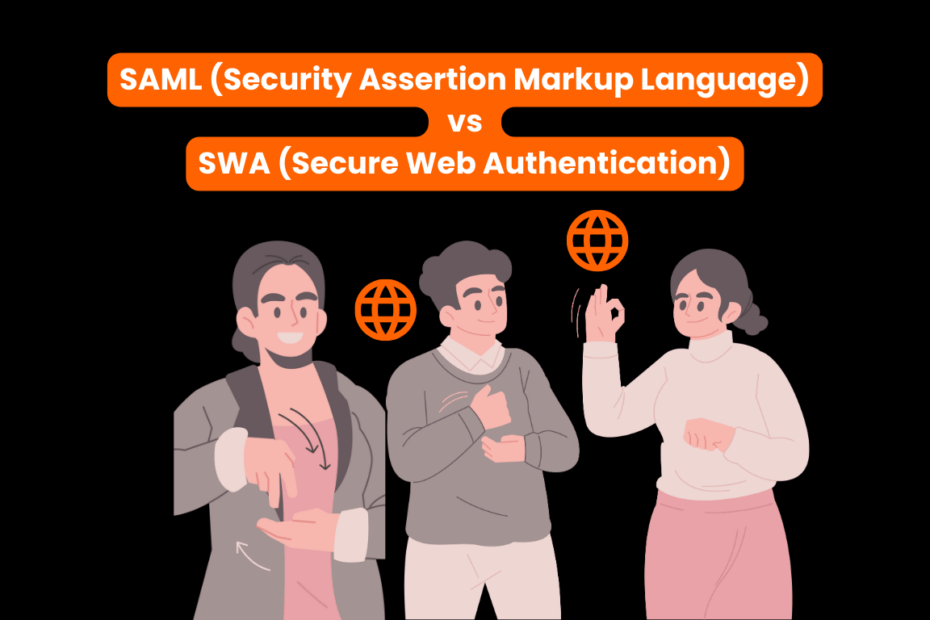SAML vs SWA : SAML (Security Assertion Markup Language) vs SWA (Secure Web Authentication)
Introduction:
In the ever-evolving landscape of cybersecurity, the choice of authentication protocols plays a pivotal role in securing digital interactions. SAML (Security Assertion Markup Language) and SWA (Secure Web Authentication) stand out as two prominent methods(SAML vs SWA). Let’s delve into the nuances of each, exploring their features, security aspects, advantages, and limitations.
Understanding SAML:
SAML, an XML-based framework, facilitates the exchange of authentication and authorization data between parties. It serves as a bridge between identity providers and service providers, ensuring secure data transmission. With features like single sign-on and robust security mechanisms, SAML has become a cornerstone in the authentication realm.
SWA Explained:
On the other hand, SWA, or Secure Web Authentication, is a method designed for secure user authentication on the web. It focuses on the simplicity of the authentication process while maintaining a high level of security. Unlike SAML, SWA operates without the need for extensive XML configurations, offering a streamlined approach to web authentication.
SAML vs SWA Security Aspects:
SAML boasts advanced security features, including digital signatures and encryption, ensuring the confidentiality and integrity of exchanged data. SWA, while secure, adopts a more straightforward approach, emphasizing user-friendly authentication without compromising safety.
SAML vs SWA Implementation Considerations:
Implementing SAML often requires a meticulous configuration process, catering to specific organizational needs. On the other hand, SWA is known for its ease of implementation, making it an attractive choice for organizations prioritizing simplicity and efficiency in web authentication.
Read More : Guide for Okta SWA Secure Web Authentication
Use Cases:
Real-world scenarios showcase the versatility of SAML in industries requiring robust authentication, such as healthcare and finance. SWA finds its application in user-friendly environments, where a seamless and secure authentication process is paramount.
Advantages of SAML vs SWA
Advantages of SAML:
SAML’s strengths lie in its ability to provide a secure and standardized way for identity verification, promoting interoperability and facilitating single sign-on across diverse platforms.
Advantages of SWA:
SWA shines in its simplicity, offering a user-friendly authentication experience without compromising on security. Its lightweight nature makes it a preferred choice for applications that prioritize ease of use.
Limitations of SAML vs SWA
Limitations of SAML:
Despite its merits, SAML can be complex to implement and may face challenges in scenarios where a lightweight solution is preferred.
Limitations of SWA:
While SWA excels in simplicity, it may not be the ideal choice for scenarios requiring extensive customization and advanced security features.
Choosing the Right Authentication Method:
When deciding between SAML and SWA, factors like organizational requirements, security considerations, and the desired level of customization must be carefully evaluated. Matching the authentication method to specific use cases ensures optimal performance.
Industry Adoption:
Industries dealing with sensitive data, such as healthcare and finance, often favor the robust security features of SAML. Meanwhile, SWA finds popularity in user-centric environments, including social media and e-commerce platforms.
Future Trends of SAML vs SWA:
SAML is witnessing ongoing advancements, with trends focusing on enhancing its adaptability to modern technologies. SWA is expected to evolve in line with user demands, emphasizing a balance between simplicity and advanced security.
Best Practices:
Implementing SAML effectively requires attention to detail in configuration and adherence to industry best practices. SWA, being user-centric, benefits from a straightforward implementation process, but organizations should still prioritize security measures.
Conclusion:
In the dynamic landscape of web authentication, the choice between SAML vs SWA hinges on organizational needs and preferences. Both methods offer unique advantages, and the decision should align with the specific requirements of the application or service. As industries evolve and user expectations shift, staying informed about the strengths and limitations of SAML and SWA becomes crucial for effective authentication strategies.
FAQs
- Is SAML more secure than SWA?
- Security depends on specific use cases. SAML offers robust features, but SWA’s simplicity may suffice for less sensitive applications.
- Which industries commonly use SAML?
- Healthcare, finance, and government sectors often leverage SAML for its strong security measures.
- Can SWA be customized for advanced security needs?
- While SWA prioritizes simplicity, it may not be the best fit for scenarios requiring extensive customization and advanced security features.
- What trends are emerging in SAML?
- SAML is adapting to modern technologies, with a focus on enhancing its flexibility and compatibility.
- Is SWA suitable for large enterprises?
- SWA’s simplicity makes it suitable for various scenarios, including large enterprises, especially those emphasizing a user-friendly experience.

